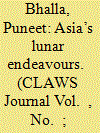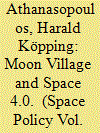|
|
|
Sort Order |
|
|
|
Items / Page
|
|
|
|
|
|
|
| Srl | Item |
| 1 |
ID:
139176


|
|
|
|
|
| Summary/Abstract |
Interest in the exploration of the Moon, much like its phases, has waxed and waned since the beginning of space exploration. The quest for the Moon was an integral part of the space race between the Soviets and the Americans in the 1960s and 1970s, which resulted in a total of 65 missions, including the six manned missions by the US, before they both shifted focus to manned space stations and missions to Mars. Strategically or militarily, the Moon did not offer them much advantage. Scientifically, there was not much that was expected to be revealed after the first few missions. Economically, there was no great rationale for continuing a high cost programme from which few commercial gains could be expected at the time. Mars offered more opportunities for national prestige, scientific discovery as well as mining prospects. In the next few decades, although there were periodic statements about the potential of lunar exploration, these did not translate into actual efforts by any space-faring nation.
|
|
|
|
|
|
|
|
|
|
|
|
|
|
|
|
| 2 |
ID:
169345


|
|
|
|
|
| Summary/Abstract |
This article discusses the Moon Village concept within the context of the increasing momentum to return human beings to the surface of the Moon. The article follows a dual objective. Firstly, the Moon Village is probably the most misunderstood among the plethora of ideas to explore the Moon scientifically and commercially. The article is therefore intended to explore what the Moon Village actually is. Secondly, the article explores the strengths and weaknesses of the Moon Village. The article is divided into three sections. The first section reviews the current Moon projects of public and private space actors, including the United States, Russia, China, SpaceX and Blue Origin. It sets the scene for the argument that the Moon Village has entered global discourse on space within a positive political environment. The second section discusses the premises of ESA chief Jan Wörner’s Moon Village concept, putting forward that the Moon Village is intended as an open concept rather than as a concrete plan. It is a process rather than a project and it is meant to initiate a global conversation on humanity’s future on the Moon. As such, the world café is an appropriate metaphor to illustrate the idea behind the Moon Village. In the third and final section a SWAT/PEST analysis is conducted to assess the feasibility of the Moon Village, highlighting that one of the major opportunities of the project is to promote international cooperation. The article concludes by supporting the institutionalist hypothesis that the Moon Village is arguably a translation of the ESA system to the global level, as participation is voluntary and as it builds on the strengths of each cooperation partner. As such, the Moon Village in indeed a new way of doing space on the global level.
|
|
|
|
|
|
|
|
|
|
|
|
|
|
|
|
| 3 |
ID:
148491


|
|
|
|
|
| Summary/Abstract |
The concept of a space elevator dates back to Tsilokovsky, but they are not commonly considered in near-term plans for space exploration, perhaps because a terrestrial elevator would not be possible without considerable improvements in tether material. A Lunar Space Elevator (LSE), however, can be built with current technology using commercially available tether polymers. This paper considers missions leading to infrastructure capable of shortening the time, lowering the cost and enhancing the capabilities of robotic and human explorers. These missions use planetary scale tethers, strings many thousands of kilometers long stabilized either by rotation or by gravitational gradients. These systems promise major reduction in transport costs versus chemical rockets, in a rapid timeframe, for a modest investment. Science will thus benefit as well as commercial activities.
|
|
|
|
|
|
|
|
|
|
|
|
|
|
|
|
| 4 |
ID:
142581


|
|
|
|
|
| Summary/Abstract |
Given the renewed interest in exploring and exploiting the resources of the Moon, this paper will explore the proposition that sustainability should be a fundamental consideration when formulating policy in respect of regulating lunar activities. The current lunar regulatory framework, however, is a product of the Cold War and conceived at a time when sustainability and space environmental issues were not within the contemplation of policy makers. Yet there is an increasing awareness of the need for space sustainability within the space community and this should be focused towards shaping policy in respect of lunar exploration. Inherently linked to this is a new multi-sectored era of space activity with emerging space nations and private companies competing alongside established space actors to exploit the natural resources of the Moon. Disputes over legally binding methods of lunar resource allocation are harming the chances of obtaining any consensus regarding sustainable development. This discussion will show that there is no compelling evidence that commercial mining of the Moon will yield the vast natural resources that would make such a venture economically viable. It will be advocated that a policy of promoting the use of the moon for scientific and exploratory purposes by means of existing fora such as IDAC and using non-binding codes to create normative values of sustainability should be placed at the heart of lunar exploration policy.
|
|
|
|
|
|
|
|
|
|
|
|
|
|
|
|
|
|
|
|
|